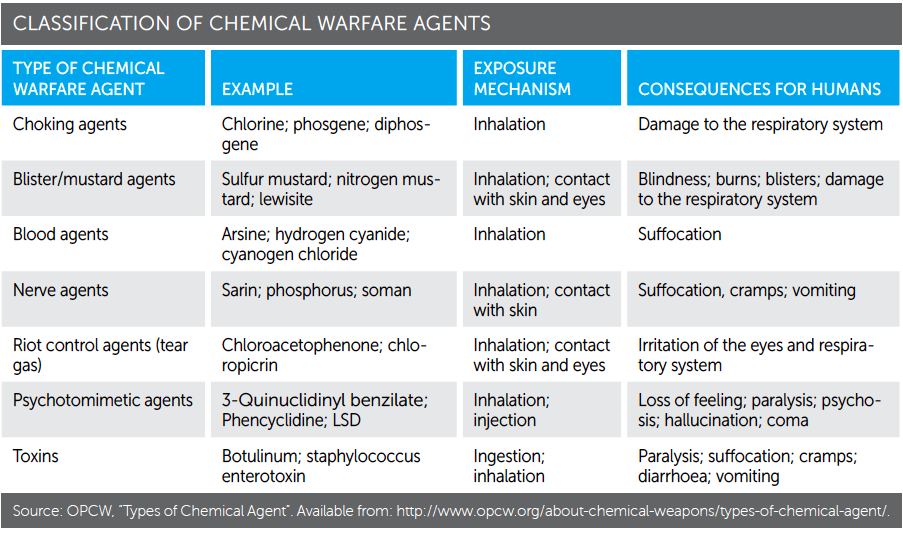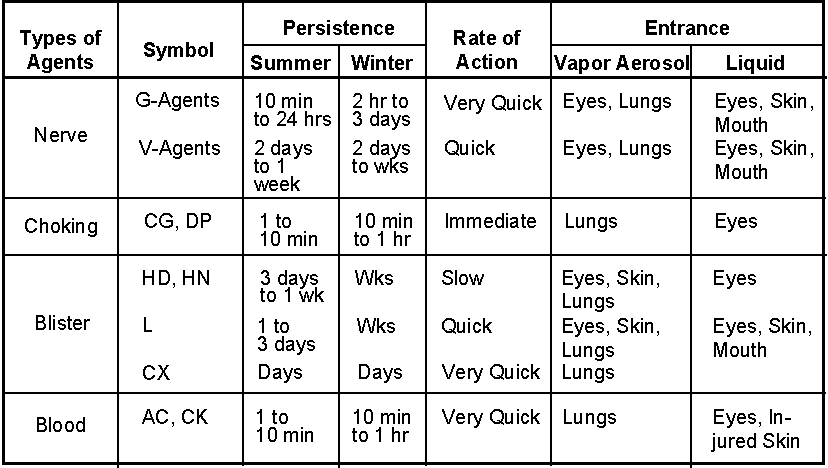
No, I’m not talking about the television networks; they can’t kill you, just dim your intelligence and contaminate you with incorrect information. In the 50’s, the risk was from what were called Atomic, Biological and Chemical weapons, thus ABC. During the cold war, the term changed to NBC, or Nuclear, Biological and Chemical. This was to include “hydrogen” (“thermonuclear”, including fusion) and “neutron” (designed for maximum radiation and minimum blast) bombs with the original “atomic” (using fission only) bombs. Nowadays, the term has been expanded to CBRNe. This refers to “all” the current “weapons of mass destruction”, Chemical, Biological, Radiological, Nuclear and sometimes “enhanced (improvised) explosive”. I don’t know why an “improvised” explosive device is considered any worse than a military or other “dedicated” explosive device.
The “Nuclear” concept has the short term (fireball, blast and heat) aspects and the longer term (radiation and fallout) aspects. “Radiological” is a relatively new concept dealing with the concept of a “dirty bomb“. This is a standard explosive which is surrounded with radioactive material. It does not have the destructive power or radiation of a nuclear explosion, but does spread radioactive material around, potentially exposing victims to the radiation, and making the area unsafe until it is cleaned up or the radioactive material decays to a safe level.
Biological weapons attempt to use disease as a weapon against a population; the agent is bacterial or viral or spores (including fungal). The key to these is that usually there is a period of time between exposure and symptoms, and transmission across a target area is accomplished by “infection” – people with the disease unknowingly (or uncaringly) infecting other people.
Chemical weapons are another anti-personnel weapon which attempts to poison, disable or disorient a population. This can be a single, basic chemical or a complex mix such as a nerve agent; the chemical can have been developed for non-weapon uses and just be adapted for weapon use, or it could have been developed strictly as a weapon.
Biological Weapons
As mentioned, the long term transmission of biological weapons is via infection. An area may be contaminated by filling the air with an aerosol form, or covering it with a liquid form, but often it is more effective (and technically easier) to send infectious people into the target population. The design of these weapons focus on the resistance of the disease agent outside of a host (to make it difficult to sanitize an affected area and infect as many “primary” hosts as possible), the lethality of the disease (maximize the percentage of victims who are disabled or die), the susceptibility to treatment or inoculation (to minimize victims being easily cured or made resistant to infection), and the length of the incubation period (a long time between exposure and symptoms to maximize the period each carrier is infectious and mobile, or a short time to make it harder to combat).
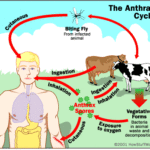 Thus, the trick is to avoid becoming infected. This generally occurs when the disease agent (bacteria, virus or spore) enters the body, most commonly via the mouth, nose, eyes or a break in the skin. The disease agent can be in an aerosol form which is breathed or a liquid which gets on the hands and is transferred to an opening or into a wound. It can also be in what is eaten or drunk. If you can prevent these common sources of infection, then it would be unlikely that you will be infected, unless someone injects you or you are in long term close contact with a carrier or their environment. To reduce the odds of infection, use a mask over your mouth and nose which can filter out and/or kill the disease agent, goggles which seal around your eyes, and clothing which will keep the disease agent away from your skin, or at least any breaks in your skin. Decontamination; that is safe removal and containment of the clothing upon return to a “safe” location, and cleaning any possibly exposed parts of the body, will be of great importance.
Thus, the trick is to avoid becoming infected. This generally occurs when the disease agent (bacteria, virus or spore) enters the body, most commonly via the mouth, nose, eyes or a break in the skin. The disease agent can be in an aerosol form which is breathed or a liquid which gets on the hands and is transferred to an opening or into a wound. It can also be in what is eaten or drunk. If you can prevent these common sources of infection, then it would be unlikely that you will be infected, unless someone injects you or you are in long term close contact with a carrier or their environment. To reduce the odds of infection, use a mask over your mouth and nose which can filter out and/or kill the disease agent, goggles which seal around your eyes, and clothing which will keep the disease agent away from your skin, or at least any breaks in your skin. Decontamination; that is safe removal and containment of the clothing upon return to a “safe” location, and cleaning any possibly exposed parts of the body, will be of great importance.
Since it is difficult to keep up avoidance of infection long term, a secondary focus is to kill the disease agent not yet (or any more) in a victim, and to quarantine those who are infected. There are a number of ways to kill disease agents: heat, ultraviolet and disinfectants are the most common. Victims of bacterial weapons may respond to antibiotics, but often viruses don’t have effective anti-virals.
Note that a biological product, such as Botulism toxin is NOT a Biological weapon, but a Chemical one. A Biological weapon is one which is “alive” or at least becomes alive in the victim, and works by multiplying to the point where the victim’s system is overwhelmed. The diseases used tend to be naturally occurring, although the weaponized ones may have been “tweaked”.
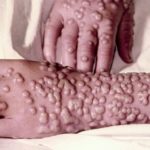 Perhaps the most noted modern biological weapon is Anthrax (Bacillus Anthracis). Others include Smallpox (Variola major), Tularemia (Francisella tularensis), Plague (Yersinia pestis), Bunyavirus (Bunyaviridae family – Nairovirus, Phlebovirus and Hantavirus), Ebola Virus and Marburg Virus (another Hemorrhagic Fever similar to Ebola). Some people think that influenza has potential to be “improved” into a useful weapon.
Perhaps the most noted modern biological weapon is Anthrax (Bacillus Anthracis). Others include Smallpox (Variola major), Tularemia (Francisella tularensis), Plague (Yersinia pestis), Bunyavirus (Bunyaviridae family – Nairovirus, Phlebovirus and Hantavirus), Ebola Virus and Marburg Virus (another Hemorrhagic Fever similar to Ebola). Some people think that influenza has potential to be “improved” into a useful weapon.
Anthrax has not only the bacteriological effects, but the bacterium is one of those which also produce toxins. Treatment varies depending on how you were infected. If the infection was through a wound or injection, often a long course of Ciprofloxican or a Doxycycline antibiotic will do the trick. If spores were inhaled, that is a medical emergency which antibiotics alone may not suffice for. There are anti-toxins being developed for cases where the toxin has been produced in the victim in quantity, but at this time these are still experimental. Those at risk (veterinarians and other professionals who deal with animals, and the military) can get a vaccine against Anthrax. They are also working to develop an oral vaccine which might be available more widely. Anthrax is not as infectious as many diseases, so the optimal way of introducing it into a population is dispersing an aerosol to encourage inhalation of the agent.
Chemical Weapons
Any weaponized material which is not “alive” (or potentially alive), including substances produced by or from biological elements, is considered Chemical. This material is finite in quantity; it does not reproduce, and works by affecting the body directly. It can be a gas, liquid, powder or other solid form. It can be distributed by explosion or other mechanical distribution, or it can be concealed in food or water or many other products. Effects can be physical damage, death, incapacitation or disorientation; effects can occur ‘instantaneously’ or after a while, and can be permanent or temporary.
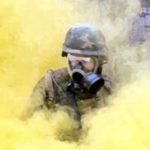 When developing a chemical weapon, one tends to focus not only in producing the desired effect, but the “volatility” or how stable it is. Chemicals which are volatile (unstable) tend to “go away” or become inactive quickly, thus exhibiting low “persistence”. This might be of interest if you plan to send personnel in shortly after the weapon. On the other hand, if the goal is to cause as much damage as possible, high persistence would be preferable.
When developing a chemical weapon, one tends to focus not only in producing the desired effect, but the “volatility” or how stable it is. Chemicals which are volatile (unstable) tend to “go away” or become inactive quickly, thus exhibiting low “persistence”. This might be of interest if you plan to send personnel in shortly after the weapon. On the other hand, if the goal is to cause as much damage as possible, high persistence would be preferable.
Harassing agents
These are substances that are not intended to kill or injure. Casualty effects are not anticipated to exceed 24 hours, nor do they often require medical attention. These include tear agents (pain to eyes and irritation to mucous membranes), vomiting agents (produce congestion, coughing, sneezing, and eventually nausea), and malodorants (strong, unpleasant smell with powerful averse effects, such as a skunk uses.)
Incapacitating agents
These are substances that produce debilitating effects with limited probability of permanent injury or loss of life. The casualty effects typically last over 24 hours, and though medical evacuation and isolation is recommended, it is usually not required for complete recovery. Most are psychological agents which cause mental disturbances such as delirium or hallucination. A common example is LSD (Lysergic acid diethylamide). Tranquilizers would also be incapacitating agents, but would be other than psychological in nature.
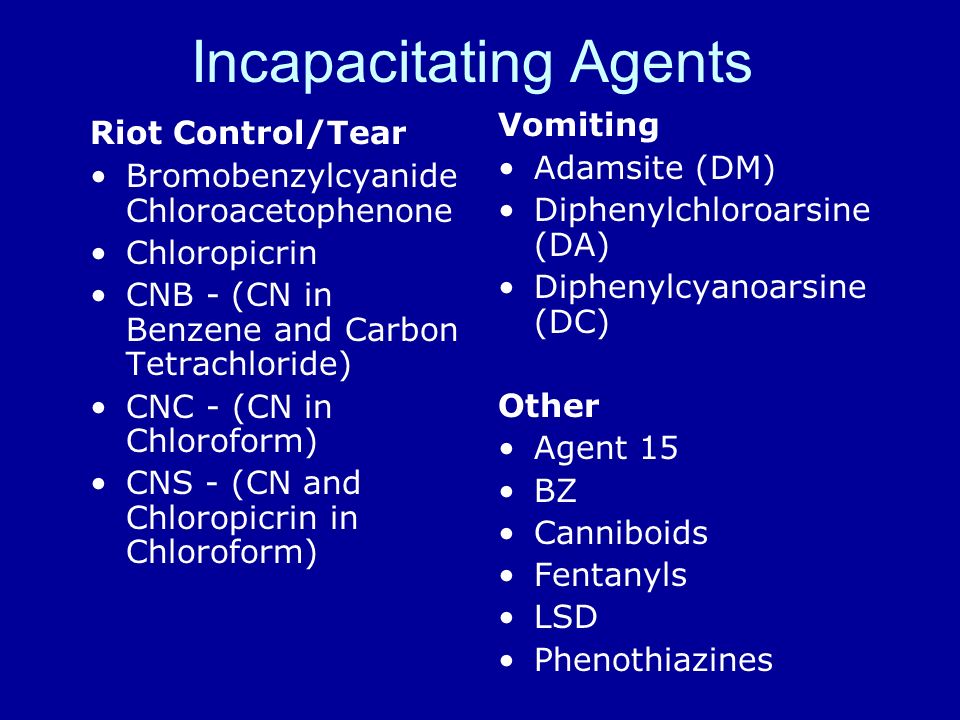
Vomiting. Adamsite (DM) Diphenylchloroarsine (DA) Diphenylcyanoarsine (DC) Other. Agent 15. BZ. Canniboids. Fentanyls. LSD. Phenothiazines. Riot Control/Tear. Bromobenzylcyanide Chloroacetophenone. Chloropicrin. CNB – (CN in Benzene and Carbon Tetrachloride) CNC – (CN in Chloroform) CNS – (CN and Chloropicrin in Chloroform)
Harassing agents and incapacitating agents are considered NON-LETHAL weapons which are temporary in nature. Note that they can result in the death of a small percentage of people affected due to sensitivity, other health issues or unintended consequence (a LSD victim thinking he can fly and jumping off a building). All other chemical weapons are considered LETHAL weapons, as they are intended to produce casualties without regard to long-term consequences or loss of life; the injuries they cause require medical treatment.
Blister agents
These irritate and cause injury to the skin, as well as the eyes, or any other tissue they contact (including internal tissues if breathed).
Vesicants – These are substances that produce large fluid-filled blisters on the skin, for example, various formulas of mustard gas.
Urticants – These are substances that produce a painful weal on the skin. Sometimes they are called skin necrotizers. The most common is Phosgene oxime.
Blood agents
These substances are metabolic poisons that interfere with the life-sustaining processes of the blood, such as Hydrogen cyanide or Arsine (a compound of arsenic).
Choking agents
These substances are sometime referred to as pulmonary agent or lung irritants and cause injury to the lung-blood barrier, preventing oxygen from getting into the blood. This results in coma or death from Asphyxia (severely deficient supply of oxygen to the body). These are commonly gasses, such as Chlorine or Phosgene.
Nerve agents
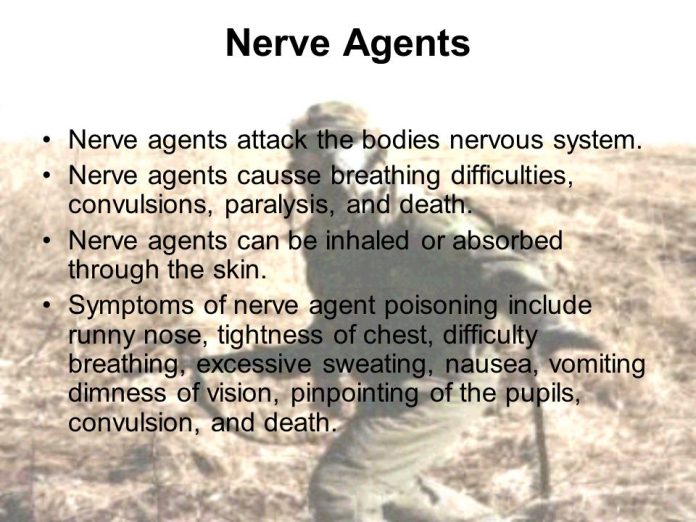
Nerve agents are substances that disrupt the chemical communications through the nervous system. The most common method of doing this is by preventing the normal control (destruction) of unintended acetylcholine in the nerve fiber, leading to a perpetual state of excitement in the nerve. This causes constant muscle contraction and the eventual exhaustion of the muscles leading to respiratory failure and death. The other method is a neurotoxin, Tetrodotoxin, which blocks nerve cells from firing, preventing muscles from contracting, and again resulting in respiratory failure.
There are a number of “series” of nerve agents. G series are high volatility agents that are typically used for a nonpersistent to semipersistent effect. Sarin is an example of this series. V series (VE, VG, VM, VX) have low volatility and are typically used for a persistent effect or liquid contact hazard. GV series (GV, Novichok) have volatility between the V and G agents and are typically used for a semi-persistent to persistent effect. These all affect acetylcholine control. The remaining class is called T series and is related to the Tetrodotoxin in puffer fish and some other marine creatures.
For those exposed to a nerve agent which prevents acetylcholine control, the military has (or had) the NAAK (Mark 1 Nerve Agent Antidote Kit) consisting of an auto-injector of Atropine and one of pralidoxime chloride. Each soldier had three kits, one which could be self administered, and the other two which could be buddy administered if convulsions start. The NAAK seems to have been replaced by the ATNAA (Antidote Treatment — Nerve Agent Auto-Injector) with the same two drugs in a single injector; it appears to not be available to civilians. However the FDA has recently approved Duodote, a similar single injector system for civilian use. It appears to go for about $60 each at regular pharmacies, but will require a prescription.
For someone convulsing, the military is (or at least was) issued an additional injector of Diazepam known as CANA (Convulsant Antidote for Nerve Agent) to be applied after the three NAAK kits.
There is currently no (known) antidote for T series nerve agents, which means that someone who would use one of these is probably insane (since it could affect them just as badly as the enemy).
Other agents
Pretty much anything which is toxic or harmful can be used as a chemical weapon. Consider the “acid attacks” occurring in the UK and other places. If you ever mix bleach and another product with acid or ammonia, you will regret it (poisonous vapors will be produced). A large dose of insulin or nicotine can be deadly. There are plants which are poisonous, such as some species of mushroom and Nightshade (Belladonna). And so on for a very long list.
One interesting weapon is Botulinum toxin produced by botulism bacteria. There are several types of this; types A and B are often used medically to treat muscle spasms (or thin lips and wrinkles). Think Botox. Type H is the deadliest substance in the world – an injection of only 2-billionths of a gram (2 ng) can cause death to an adult. Fifty grams is enough to kill the population of planet Earth, 50 grams is 1.7 ounces is less than 4 tablespoons. Another interesting weapon is Ricin, produced from the remains of the castor bean after producing the castor oil. This weapon acts by preventing protein synthesis at the cellular level. This means cells slowly grind to a halt and essential operations cease, leading to cellular death.
There are various detectors for the presence of some chemical weapons. The most reasonable tend to be badges or booklets of test papers; more extensive test kits mostly are quite expensive and have a relatively short shelf life.
How to Survive Chemical or Biological Attacks
A guaranteed way it is actually very simple in concept. Select the people you need or want to have with you, isolate them for a month to make sure they have no diseases, and then move into an air-tight residence with a chemical/biological air filter to bring in safe air, a stock of safe food, and water purification capability. And never open the door again. Of course, you might see some problems with this methodology. First of all, getting that air-tight residence will be impractical for most people due to the cost and bureaucratic impediments. Besides, even if nobody ever has to leave, which is pretty unlikely, eventually you will run out of something critical and have to go out for supplies. There is equipment to keep you safe “out there” and you could have an air lock and decontamination setup at the entrance to keep the residence sterile. But let’s face it, full protection gear is not only fallible, but likely to not go over well with the rest of the public.
Practically, you want to keep your infection risks down by staying away from other people as much as you can. And remember your PPG (personal protection gear) of mask, and if you can get away with it, goggles. Plus, have a bunch of exam gloves for whenever you need to touch something which might be infected by the previous person who was near it (which is usually EVERYTHING). Have hand sanitizer available in case you accidentally touch anything when not wearing gloves. Having a decontamination system at your entrance, for you AND anything you are bringing in is a critical idea. Keep a close ear on any unusual medical news, and at the first sign of anything potentially biological weapon related, go to your highest level of infection prevention (essentially, isolation). And remember, insects can carry disease, so be prepared to keep them out as much as practical, and take care of any which do get in.
Biological safety can be fairly long term; you have to wait for the disease to “burn itself out”; that is, reach a condition where nobody else is contagious and every existing source of the disease is quarantined or destroyed. Chemical safety is much shorter term, but rather more complicated. It would be a challenge for a biological weapon to get inside your house unless you bring it in or let it in. Chemical weapons can get inside rather more easily. If your residence is not air tight (and the odds are that it is not), you need to have the means at hand to make it more so upon demand. This often can be done with plastic sheeting and duct tape. Know what needs to be sealed and have the tools and supplies right there. A way of filtering what air does come in would be quite useful because otherwise either the weapon can get in, or you will die when all the oxygen is used up. When you have to go out, you’ll need full protection, and your need for protection is more important than what other people think. Be alert for violence from those who don’t have protection or are just plain nut jobs.
Basically, this level of protection consists of a CBRN rated gas mask and a suit which keeps the chemicals off your entire body, since some chemical weapons affect the skin, and others can be absorbed through the skin. Unfortunately, some chemical weapons are designed to defeat the protections against them, so masks and suits need to be continuously improved. Thus your CBRN mask should be new and a recent model to ensure it has the latest technology and is in a condition which is reliable and effective (that is, not “expired”). Surplus masks may be cheap, but the odds they will protect you are not favorable. It will probably cost you at least $200 for a good mask. You’ll need a supply of CBRN filter canisters as well, at about $45 each and up. How long a filter is good for is difficult to know in advance, but as an estimate, plan on getting about eight hours out of a filter. It is best to go for a mask which uses standard 40mm NATO filter attachment; they are quick to install, easier to find, and harder to screw up. Sometimes you can get “6-packs” at a discount. Be aware of the expiration date of your filters. Some people claim that they are “useless” after this date; some people claim they are still useful “for a while” if sealed, and a few filters (which use asbestos, Chromium or other harmful chemicals) might be toxic when expired.
As for the suit, Lawrence Livermore labs are working on “smart” protective clothing which protects against biological weapons and senses chemical agents and increases the protection for them. This may or may not be available now, but I’ll bet even if you could find it for sale, you would not be able to afford it. What you might be able to get is military MOPP (Mission Oriented Protective Posture) at least level four gear (lower level gear may be cheaper, but won’t provide as much protection). This outfit is thick and does not breathe well, which can cause you to overheat, but it does pretty much protect from chemical weapons. I was not able to find any currently available which guaranteed to be level four or higher, so cannot comment on price or availability. The ones I did find were in the $50 to $100 range, which seemed suspiciously low.
Furthermore, many stated they were “surplus”, and these garments seem to have a shelf life of ten years or so when sealed in a package, and only a year or two if the package seal is broken. Even it you did find a high level outfit surplus, it might not be any good by the time you needed it. There appears to be a better consumer option, generically known as CPO and/or CPU (Chemical Protective Outergarments or Undergarments), which seem to be of a similar level of protection to MOPP level four, and available in the $200 to $350 range for Rampart offerings. Gore-Tex appears to have an interesting version as well, but I could not find any for sale to civilians. These garments often don’t include gloves or foot coverings, and some don’t include head covering, so make sure you have the parts to cover these areas as well, and the appropriate materials to seal between them and the suit and the mask. This might add $50 to $100 to your cost. If this just won’t fit the budget, simple “impervious” chemical resistant suits, often of Tyvek, may be better than nothing and much more affordable.
There are “full encapsulation” suits which would be excellent against biological agents, but might be “eaten” by some chemical agents. These run from under $150 (I sure would be leery of the ones in this price range) to well over $1000, plus you would need an air supply, either SCBA (Self Contained Breathing Apparatus) which would be safe but very expensive and short lived (about an hour max before the tank needs to be refilled), or PAPR (Powered Air Purifying Respirator) which would still probably add another $600 to $1000 or more to the cost of this solution.
Other Preparations for Chemical or Biological Events
Besides the stuff already mentioned specifically to deal with a chemical or biological emergency, you will want to have all the standard survival stuff. This is because you want to be sure that your food and water is not contaminated with the weapon agent, and you want to minimize how often you have to go out among potentially infected people or areas to get necessities. There is a high probability of random violence and looting. Access to radio broadcasts is critical so you can find out what the status is of the attack and the response to it. Medical supplies will likely be in short supply. Personal hygiene supplies will be important; it would be embarrassing to defeat an enemy’s chemical or biological attack only to succumb to your own lack of hygiene.



